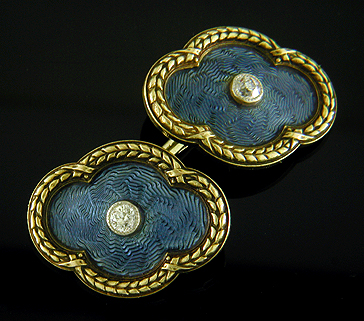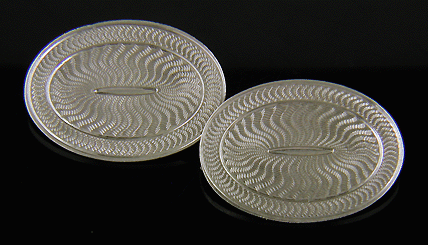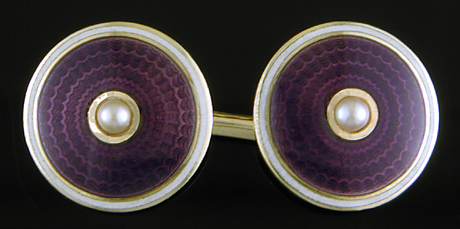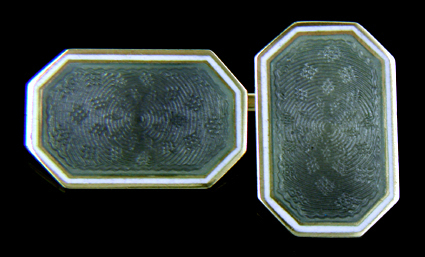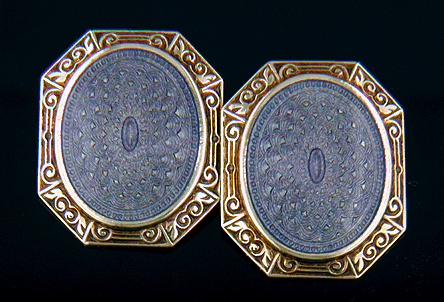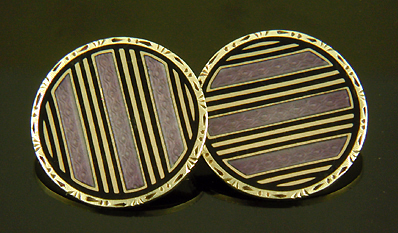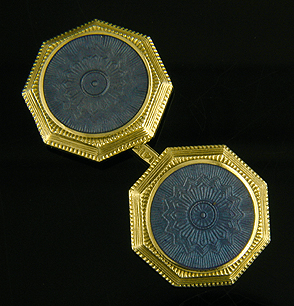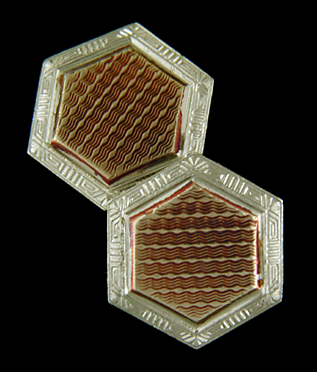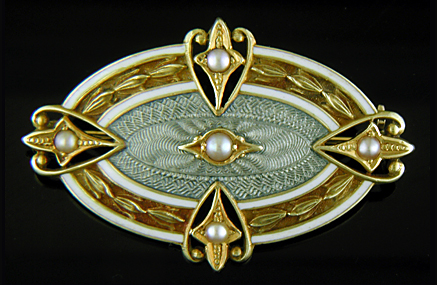
The Art of the Enameler
|
|
One of the pleasures of antique cufflinks is exploring the many decorative designs and techniques with which they were created and embellished. In this regard, some of finest and rarest cufflinks are those that bring together the exacting arts of guilloche (engine turning) and enamel work. Guilloche (or engine turning) is the art of mechanically engraving intricate, finely detailed patterns on metallic or other hard surfaces. Among the common guilloche designs are zigzags and pinstripes, concentric circles and stars, shimmering pinwheels and myriad other motifs. The Carrington platinum cufflinks pictured above are a beautiful example with a center of wavy radiating curves surrounded by an equally intricate border. The depth and fineness of the engraving gives the design a mesmerizing three-dimensional appearance. 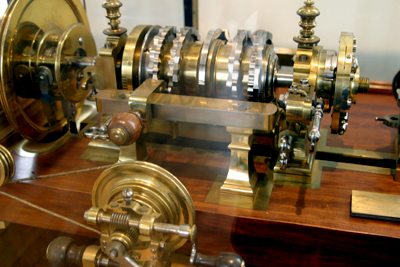
The allure of the machine - a rose engine lathe, circa 1800. The art of guilloche first emerged in Germany during the early 1500s with the invention of the rose engine lathe (a later example pictured above) - an intricate device of offset gears, cams and cutters for engraving precise elaborate designs. Initially applied to ivory and other softer materials, the technique was soon adapted to metal and glass. At one time engine turning (or more poetically "rose turning") was an enthusiastically pursued pastime of rulers and noblemen - sort of Spirograph for the well heeled. The rose lathes are often finely crafted machines of wood and brass that are as intriguing and beautiful as the designs they create. Enameling is the art of applying and then melting powdered glass onto a metallic or other hard surface so that it fuses to the substrate. As the powdered glass cools, it forms a vitreous, lustrous layer. Enameled jewelry has been found among the ruins of the Egypt, Mycenae and other early civilizations. More contemporary example of the enameler's art is offered by the Carrington & Co. cufflinks pictured above. When an engine-turned surface is covered with a layer of translucent enamel magic happens. The color of the enamel pools in the valleys of the engraved lines highlighting the design with subtle shades of color. In the more deeply cut sections of the engraving the color is more intense and the engraved pattern pops into stunning relief. The effect is mesmerizing. Enthusiasm for guilloche enameling during the late 19th and early 20th century was in large part ignited by the creations of the Russian jewelry master Peter Carl Faberge. Faberge and his colleagues created a dazzling array of beautifully enameled jewels and objets d'art. In doing so they elevated the arts of engine turning and enameling to new heights. Among Faberge's many enameled creations were cufflinks, desk accessories and the famous Faberge Easter Eggs. The above Carrington cufflinks may have been inspired by Faberge's work. The subdued blue-gray enamel and classic canted-corner shape of the cufflinks recalls the elegant jewels of the Russian master. They illustrate the simple, elegant designs favored by Carrington & Co. and the firm's uncompromising commitment to craftsmanship. Equal to Carrington & Co. in creating beautiful guilloche enamel cufflinks was William Huger & Company. Of the two firms Carrington was the more prolific. But what Huger lacked in production numbers the firm made up for with the beauty of its designs, as illustrated by the above exquisite example. The above Huger cufflink features an intricately engine-turned pattern wedded with light blue enamel. The effect is like exploding fire works in a dark sky. Gold borders of foliate and geometric scrolls frame the enamel centers. To close I offer several more examples of guilloche enameling, three cufflinks and a striking brooch. One of the cufflinks (above) is by Krementz & Co., a prolific and seemingly ubiquitous manufacturer of fine cufflinks during the late 19th and 20th centuries. The other two cufflinks were created by "small batch" makers - Jacob Hookaylo and Taylor & Co. - who like William Huger created extraordinarily beautiful cufflinks, but only in tantalizing limited numbers.
The final example is a stunning brooch created by Wordley,
Allsopp & Bliss around 1910 with all the sumptuous
splendor of the Gilded Age. The brooch features a light
blue guilloche center with opaque white enamel borders framing
richly detailed gold work. Small pearls are set in
stylized fleurs-de-lis at the cardinal points with a fifth
pearl set in the center. Given the diminutive size of
the brooch (just over l 1/4" by less than 1"), it is
extraordinary that so many design elements with such a high
level of detail have been tastefully wedded in so small a
space. To view guilloche enamel and other fine
cufflinks, |
| |
||
| Antique Jewelry Galleries Antique Cufflink Gallery If you have any questions, suggestions or comments, I can be reached at (978 525-8951) or arthur@jewelryexpert.com.
|
||
|
|
